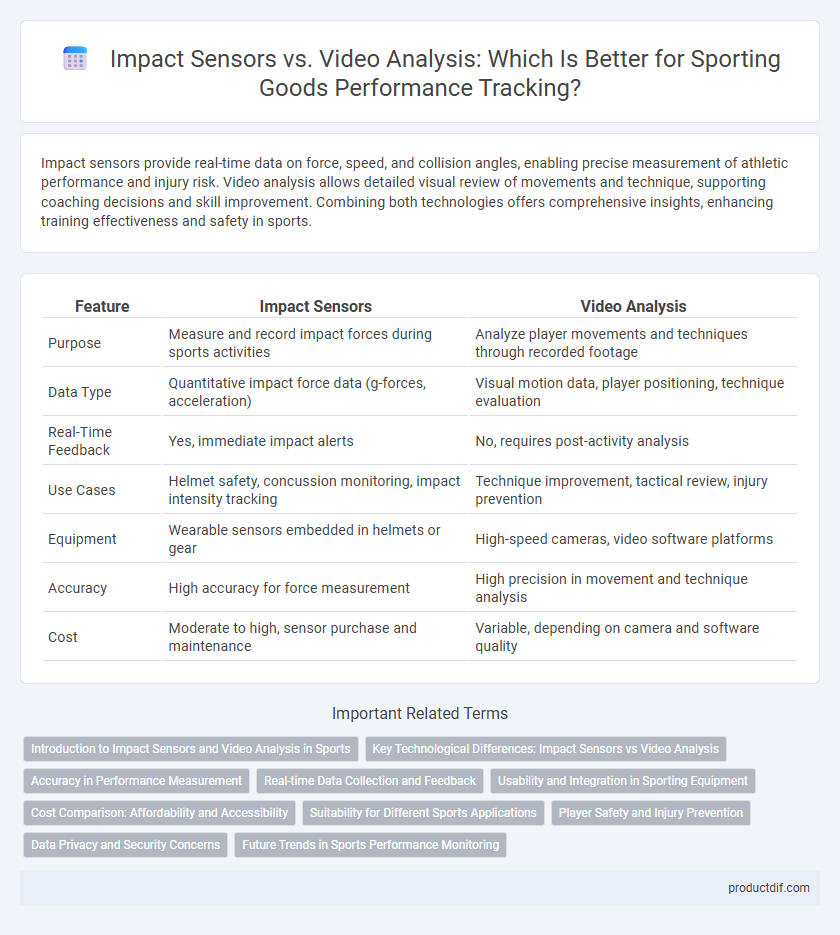Impact sensors provide real-time data on force, speed, and collision angles, enabling precise measurement of athletic performance and injury risk. Video analysis allows detailed visual review of movements and technique, supporting coaching decisions and skill improvement. Combining both technologies offers comprehensive insights, enhancing training effectiveness and safety in sports.
Table of Comparison
| Feature | Impact Sensors | Video Analysis |
|---|---|---|
| Purpose | Measure and record impact forces during sports activities | Analyze player movements and techniques through recorded footage |
| Data Type | Quantitative impact force data (g-forces, acceleration) | Visual motion data, player positioning, technique evaluation |
| Real-Time Feedback | Yes, immediate impact alerts | No, requires post-activity analysis |
| Use Cases | Helmet safety, concussion monitoring, impact intensity tracking | Technique improvement, tactical review, injury prevention |
| Equipment | Wearable sensors embedded in helmets or gear | High-speed cameras, video software platforms |
| Accuracy | High accuracy for force measurement | High precision in movement and technique analysis |
| Cost | Moderate to high, sensor purchase and maintenance | Variable, depending on camera and software quality |
Introduction to Impact Sensors and Video Analysis in Sports
Impact sensors in sports provide real-time data on force, acceleration, and impact location to monitor athlete performance and prevent injuries. Video analysis supplements this by offering detailed visual evaluation of techniques, form, and gameplay strategy through frame-by-frame breakdowns. Combining impact sensors with video analysis enhances training precision and injury management in athletic performance optimization.
Key Technological Differences: Impact Sensors vs Video Analysis
Impact sensors utilize embedded accelerometers and gyroscopes to capture real-time biomechanical force data during athletic activities, enabling precise measurement of impact magnitude and location. Video analysis employs high-resolution cameras combined with advanced motion-tracking algorithms to visually assess technique, posture, and movement patterns over time, providing a comprehensive qualitative evaluation. While impact sensors deliver quantitative force metrics essential for immediate injury prevention, video analysis offers contextual insights critical for long-term skill development and performance optimization.
Accuracy in Performance Measurement
Impact sensors provide precise, real-time data on force and motion, enabling accurate measurement of key performance metrics in sports such as acceleration, impact severity, and movement patterns. Video analysis offers comprehensive visual feedback, allowing for detailed biomechanical evaluation, but it may be limited by frame rate and angle, affecting measurement accuracy. Combining impact sensors with high-speed video analysis enhances overall accuracy, delivering a more complete and reliable assessment of athletic performance.
Real-time Data Collection and Feedback
Impact sensors provide real-time data collection and immediate feedback on force and motion during athletic performance, enabling instant adjustments for injury prevention and technique improvement. Video analysis, while offering detailed post-activity insights through frame-by-frame review, lacks the immediacy of data delivery crucial for on-the-spot corrections. Integrating impact sensors enhances the responsiveness and precision of training programs compared to traditional video-based methods.
Usability and Integration in Sporting Equipment
Impact sensors offer seamless integration directly into sporting equipment, providing real-time data with high usability for athletes and coaches during training and competition. Video analysis requires additional setup with cameras and software, often limiting immediate feedback and complicating usability for fast-paced environments. Wearable impact sensors enhance practical data collection without obstructing movement, making them more user-friendly compared to video analysis systems.
Cost Comparison: Affordability and Accessibility
Impact sensors offer a more affordable and accessible solution for athletes and coaches, with prices typically ranging from $100 to $500, making them suitable for individual use and small teams. Video analysis systems, often requiring professional software and high-quality cameras, can cost upwards of $1,000 to $5,000, limiting accessibility to larger organizations or institutions. The lower initial investment and ease of use make impact sensors a cost-effective choice for real-time performance monitoring in sporting goods technology.
Suitability for Different Sports Applications
Impact sensors provide real-time data on forces experienced during contact sports like football and hockey, making them ideal for monitoring player safety and preventing injuries. Video analysis excels in precision technique assessment and strategy evaluation, offering detailed visual feedback suitable for sports such as gymnastics, tennis, and basketball. Combining impact sensors and video analysis enhances performance optimization and injury prevention across diverse sporting disciplines.
Player Safety and Injury Prevention
Impact sensors provide real-time, precise data on force magnitude and location, enabling immediate intervention to prevent severe injuries in sports. Video analysis offers comprehensive visual insights for post-event review, assisting in identifying injury patterns and improving training techniques. Combining impact sensors with video analysis enhances player safety by delivering accurate, actionable information to coaches and medical staff for timely prevention strategies.
Data Privacy and Security Concerns
Impact sensors in sporting goods offer real-time data collection directly from the athlete, minimizing data exposure by limiting external data transmission, which enhances privacy and security. Video analysis, while providing detailed visual insights, often requires extensive data storage and cloud processing, increasing the risk of unauthorized access and potential breaches. Protecting athlete data demands stringent encryption protocols and compliance with privacy regulations to safeguard sensitive performance metrics captured by both technologies.
Future Trends in Sports Performance Monitoring
Impact sensors offer real-time, precise biomechanical data critical for injury prevention and performance optimization, while video analysis provides comprehensive visual feedback for technique refinement. Future trends in sports performance monitoring emphasize the integration of AI-driven data analytics and wearable technologies, enhancing the accuracy and immediacy of athlete assessments. Advances in sensor miniaturization and cloud computing are expected to revolutionize personalized training programs and injury diagnostics across all sports disciplines.
Impact sensors vs Video analysis Infographic

 productdif.com
productdif.com